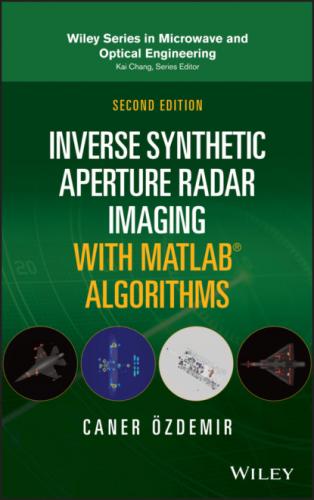where
(2.5)
This is the scattered electric field in the far field using the PO approximation. As will be explored in Chapter 4, this formula will constitute a basis for the derivation of inverse synthetic aperture radar (ISAR) imaging algorithm.
2.3 Radar Cross Section
Radar cross section (RCS) can be regarded as the measure of the EM energy intercepted and reradiated by an object (or target). The unit of RCS is square‐meters (m2). RCS is generally used to categorize the object's EM reflectivity or ability to scatter the EM energy for a particular direction and at a particular frequency.
RCS is the main parameter in detection of airplanes, ships, tanks, or, more commonly, military targets. The low observable (or stealth) aircrafts/ships are designed to give very low RCS values so that they cannot be detected by the opponent's radar. These special design features for low‐observable platforms include planar body surfaces that reflect the incoming wave to another direction and/or using special radar‐absorbing material (RAM)‐based coating or paint. Passenger airplanes, on the other hand, usually provide relatively much higher RCS values due to bare metallic surfaces that reflect almost all of the incoming energy, rounded shape design that scatters the EM wave almost in all directions, and canonical shapes and cavities (such as engine ducts) that scatter most of the incident EM wave in the backward direction. Furthermore, they are also big in size compared to fighters. Therefore, their RCS values are much higher than specially designed stealth aircrafts.
The concept of RCS plays an important role in radar imaging. In fact, monostatic ISAR images of a target are constructed by backscattered field measurements (or RCS measurements). If the backscattered RCS measurements from the target for different frequencies and different look angles are transformed back to where the scattering phenomena originate, what we basically obtained is nothing but the “ISAR image” of that target.
2.3.1 Definition of RCS
RCS can be briefly described as the effective echoing area of the target when it is illuminated by a plane wave as illustrated in Figure 2.3. RCS can also be thought of as the measure of an object's ability to scatter EM signals in the direction of the radar receiver. According to the IEEE Standard Definitions of Terms, RCS or the scattering cross section (SCS) or the echoing area is defined as the following: “For a given scatterer, upon which a plane wave is incident, that portion of the SCS corresponding to a specified polarization component of the scattered wave” (IEEE Std 145‐1993 1993).
A more formal definition of the RCS (σ) of an object can be made as the following: “It is the equivalent area intercepting the amount of power that, when scattered isotropically, produces at the radar receiver a power density Ws that is equal to the density scattered by the actual object” (Chu et al. 1991).
The formula of RCS can be derived easily, as follows: As depicted in Figure 2.3, the object (or the target) is located at R distance from the radar. Incident plane wave from the radar transmitter produces a power density of Wi at the target. If the object (or the target) has an RCS area of σ, the power reflected by that object is then equal to
Figure 2.3 The EM energy scatters in all directions when it hits a target.
(2.6)
According to the above definition of RCS, this reflected power will reradiate in all directions (isotropically). Therefore, the power density Ws of the reflected wave at the radar receiver is
(2.7)
Therefore, σ in the above equation can be left alone to give
The formal equation of RCS can be easily obtained as the following:
In an alternative definition of RCS (σ), it is the measure of the ratio of backscatter power per unit solid angle (steradian) along the radar direction to the power density that is intercepted by the object (or target)
(2.10)
If Ws is the scattered power density from the target, the amount {R2Ws} gives the scattered power per steradian at the radar receiver. Assuming that the incident power density is Wi, the RCS of a target can then be rewritten as exactly equal to formula (2.8).
As the target is located at the far field of radar, the distance R is brought to the infinity in the above equation so that we reach the formula in (2.9). The RCS can also be expressed in terms of the complex electric and magnetic fields at the target (Ei and Hi) and at the radar receiver (Es and Hs). That is,
(2.11)
As the incident EM wave hits the target, the scattered energy radiates in all directions, as illustrated in Figure 2.3. Only the scattered energy in the direction of radar receiver is included in the RCS calculation. If the radar transmitter and the receiver are collocated, the energy collected by the radar is called the backscattered energy. This radar configuration provides monostatic RCS measurement setup. If the radar receiver is placed at a different position than the transmitter, the calculated cross section will provide bistatic RCS.
The RCS area of a target does not necessarily bear a direct link with the physical cross‐sectional area of that target but depends on other parameters as well. Besides the aperture of the target seen by the radar (or projected cross section), the EM reflectivity characteristics of the target's surface and the directivity of the radar reflection caused by the target's geometric shape are the key parameters that affect the RCS value. Therefore, RCS can be approximated as the multiplication of (i) projected cross section, S;
